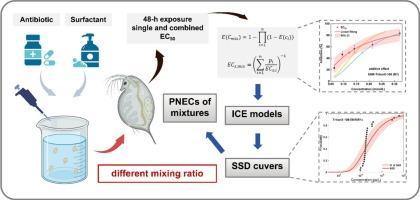混合预测无效应浓度的表面活性剂和抗生素:基于实验测试的建模
IF 4.3
3区 环境科学与生态学
Q2 BIOCHEMISTRY & MOLECULAR BIOLOGY
Comparative Biochemistry and Physiology C-toxicology & Pharmacology
Pub Date : 2025-08-27
DOI:10.1016/j.cbpc.2025.110335
引用次数: 0
摘要
抗生素的环境转运途径与表面活性剂相似,两者通常共存于水环境中,具有显著的生态风险。虽然这些化学物质的个别毒性有充分的证据,但它们的综合效应和相应的混合物预测无效应浓度(pnec)尚未得到充分的研究。氟喹诺酮类抗生素(左氧氟沙星(LEV)和恩诺沙星(ENR))和非离子表面活性剂(辛基酚聚氧乙酸酯(TritonX-100))对大水蚤(Daphnia magna)的急性毒性试验,研究了它们的联合毒性。大水蚤因其对污染物的高敏感性和生态相关性而被广泛用于淡水毒性评估的模式生物。采用浓度相加模型和独立作用模型评估联合毒性相互作用,采用种间相关估计(ICE)和种敏感性分布(SSD)模型评估不同混合比例下表面活性剂与抗生素的混合pnec。结果表明,两组二元混合物均存在协同效应。同一混合体系内不同混合比例引起的PNECs差异高达24.7%,其中Triton X-100-LEV为260.73 ~ 325.23 μg/L, Triton X-100-ENR为247.85 ~ 284.57 μg/L。该研究强调了混合效应在生态风险评估中的重要性,因为忽略这些因素可能导致对环境风险的不准确预测。本文章由计算机程序翻译,如有差异,请以英文原文为准。

Mixture predicted no-effect concentrations of surfactants and antibiotics: Modeling based on experimental testing
Environmental transport pathways of antibiotics resemble those of surfactants, and the two often co-exist in aqueous environments, represent a significant ecological risk. Although the individual toxicities of these chemicals are well-documented, their combined effects and the corresponding mixture predicted no-effect concentrations (PNECs) have not been adequately investigated. This study examined the combined toxicity of fluoroquinolone antibiotics (levofloxacin (LEV) and enrofloxacin (ENR)) and nonionic surfactant (octylphenol ethoxylate (TritonX-100)) through acute toxicity tests on Daphnia magna, a widely used model organism for freshwater toxicity assessment due to its high sensitivity to pollutants and ecological relevance. The concentration addition and independent action models were used to assess the combined toxicity interactions, while the interspecies correlation estimation (ICE) and species sensitivity distribution (SSD) models were employed to estimate the mixture PNECs of surfactants and antibiotics at different mixing ratios. The results indicated that synergistic effects were observed in both sets of binary mixtures. The differences of PNECs caused by varying mixing ratios within the same mixture system were as high as 24.7 %, with values ranging from 260.73 to 325.23 μg/L for the Triton X-100–LEV and from 247.85 to 284.57 μg/L for the Triton X-100–ENR. The study highlights the importance of mixture effects in ecological risk assessments, as ignoring these factors may lead to inaccurate predictions of environmental risks.
求助全文
通过发布文献求助,成功后即可免费获取论文全文。
去求助
来源期刊
CiteScore
7.50
自引率
5.10%
发文量
206
审稿时长
30 days
期刊介绍:
Part C: Toxicology and Pharmacology. This journal is concerned with chemical and drug action at different levels of organization, biotransformation of xenobiotics, mechanisms of toxicity, including reactive oxygen species and carcinogenesis, endocrine disruptors, natural products chemistry, and signal transduction with a molecular approach to these fields.

 求助内容:
求助内容: 应助结果提醒方式:
应助结果提醒方式:


